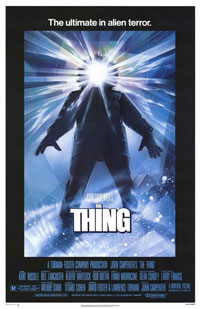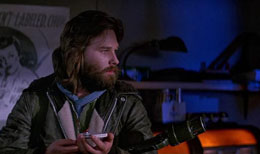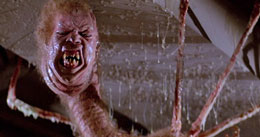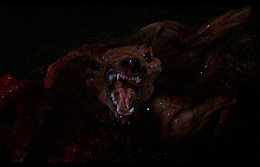Released exactly two weeks after Steven Spielberg’s E.T. (a film I have enormous affection for, but which is by no means unassailable), John Carpenter‘s The Thing could hardly have been better timed to suffer by comparison. While the former wound up with critical acclaim and the highest box office output of all-time up to that point, today’s overlooked movie endured the exact opposite.
 A quote from Carpenter indicates widespread vitriol in response to the film: “The movie was hated. Even by science-fiction fans. They thought that I had betrayed some kind of trust, and the piling on was insane.” Now, there’s no way of determining exactly what percentage of nonprofessional sci-fi fans actually hated the movie, but the critical establishment was more or less roundly situated in booming opposition.
A quote from Carpenter indicates widespread vitriol in response to the film: “The movie was hated. Even by science-fiction fans. They thought that I had betrayed some kind of trust, and the piling on was insane.” Now, there’s no way of determining exactly what percentage of nonprofessional sci-fi fans actually hated the movie, but the critical establishment was more or less roundly situated in booming opposition.
Since 1982, The Thing has been reappraised, and is now generally regarded as the massive achievement in haunting atmosphere coupled with FX supremacy that it was so undeservedly denied the distinction decades prior. But what was everyone’s problem that year? Was it really that E.T. set a standard for alien visitation films so perfect that it couldn’t be deviated from? Or is it that critics — supposedly leathery cynics, all too objective and not the least bit prone to sentimentalization — are a lot like status-quo-upholding intellectuals in their contemporary unanimity in the service of a reigning authority? And that once time passes, and the dust has settled, it’s okay to be honest about what was so obvious?
Now, to be clear, I’m almost always on the defensive when critics are under attack for an unpopular critique — when dislike of a film translates to a personal attack in a person’s mind, when disgruntled champions of a particular movie castigate its detractors with the ever-misguided: “Let’s see you make a better movie!” But there is a flipside.
 Critics can all too often be contrarian babies or bandwagon hangers-on, just as susceptible to damning peer pressure as the most gullible members of the general filmgoing public. This really seems to be the case for this since-vindicated, but still under-seen movie, the product of one of Hollywood’s most technically proficient, cinematically-intuitive directors.
Critics can all too often be contrarian babies or bandwagon hangers-on, just as susceptible to damning peer pressure as the most gullible members of the general filmgoing public. This really seems to be the case for this since-vindicated, but still under-seen movie, the product of one of Hollywood’s most technically proficient, cinematically-intuitive directors.
Based more closely off of its source material than its 1951 predecessor (The Thing From Another World) and remade this past week, John Carpenter’s The Thing tells the story of a research team in an isolated outpost in Antarctica who are trapped and slowly picked off, one by one, by an alien creature that kills and assumes the shape of any organism it wants. Drawing immediate, justifiable comparisons with Ridley Scott’s Alien from three years prior, the film relies on claustrophobia and virtual entrapment to escalate tensions and build suspense rather quickly. Where it differs from Scott’s film is in the additional element of widespread distrust.
Starring Kurt Russell, Keith David, Wilford Brimley, and a whole cavalcade of ancillary supporting characters too numerous to mention, there’s a real sense of lived-in familiarity bordering on coziness at the arctic base, however rugged, due in no small part to the gritty and realistic performances of all involved, and the personalized set design with subtle touches abound.
 After intercepting a seemingly harmless sled dog being pursued and shot at by a Norwegian chopper from a base a few miles off, Russell’s MacReady and another team member make their way to the foreign outpost only to find dead bodies, evidence of an ice excavation, and an ostensibly deceased humanoid creature with two faces that look melted into one another. They bring it back, put the infected dog in a kennel with theirs, and within hours the stability of the base unravels as the creature reveals itself to be a shape-shifting monstrosity with rapidly squirming tentacles and acid projectiles only able to be killed via immolation.
After intercepting a seemingly harmless sled dog being pursued and shot at by a Norwegian chopper from a base a few miles off, Russell’s MacReady and another team member make their way to the foreign outpost only to find dead bodies, evidence of an ice excavation, and an ostensibly deceased humanoid creature with two faces that look melted into one another. They bring it back, put the infected dog in a kennel with theirs, and within hours the stability of the base unravels as the creature reveals itself to be a shape-shifting monstrosity with rapidly squirming tentacles and acid projectiles only able to be killed via immolation.
As is expected, the crew gradually diminishes, either by exile or execution, the creepiest—both tonally and stylistically—of which being Bennings’ demise in the snow. His dead eyes, claw-like, amphibious hands, and inarticulate bellow, followed by his suddenly being set ablaze, are truly demonic in their presentation.
The creature’s necessary high-level intelligence paired with its grotesqueness and brutality make it all the more sinister; it’s not some bloodthirsty beast operating on pure instinct, but an evil force capable of perfectly mimicking organisms as complex as human beings and infiltrating their social groups undetected. Not to mention the fact that it’s also capable of intergalactic travel, and has been for tens of thousands of years. When the crew finds its ship after having been unearthed by the Norwegian camp, the visual representation is beautiful, and realistic, and consistent with the general conduct of the entire film in that it’s not the least bit dated.
 The perpetually steaming breath of the crew provides a great sense of tactility, and the day-to-day experiences touched upon (like Palmer and Childs sharing one hell of a joint over pre-taped game shows on VHS at bedtime, or Nauls blasting Stevie Wonder to the chagrin of Bennings in his adjacent room) help to really ground you as a spectator in the physical environment under exploration. The characterizations may not be extensive, but they avoid easy stereotypes, and the dire circumstances facilitate getting to know the slightly over-populated cast by drawing out their most fundamental traits as crises tend to do.
The perpetually steaming breath of the crew provides a great sense of tactility, and the day-to-day experiences touched upon (like Palmer and Childs sharing one hell of a joint over pre-taped game shows on VHS at bedtime, or Nauls blasting Stevie Wonder to the chagrin of Bennings in his adjacent room) help to really ground you as a spectator in the physical environment under exploration. The characterizations may not be extensive, but they avoid easy stereotypes, and the dire circumstances facilitate getting to know the slightly over-populated cast by drawing out their most fundamental traits as crises tend to do.
The Thing is certainly a bleak and desolate enterprise, replete with grim realizations at every advance. There are stark, daunting visuals throughout, and a pervasive, ethereally haunting score by Ennio Morricone.
The hopelessness of an isolated outpost cut off not only from civilization itself but contact with it in any way elevates the tragedy of the mayhem and carnage exponentially. The FX work is grisly and realistic (even employing good old stop-motion in a shot or two), without question on a par with its timely counterpart E.T. and its spiritual counterpart Alien, and reaffirms upon visitation how effective visual effects could be before CGI, and how a happy integration in our current age could be most satisfactory. Those gesticulating, spaghetti-like tentacles wrapped around that dog are truly delightful.




{ 1 comment }
*SPOILERS*
What I’d really like to know, is do you think MacReady or Childs was “The Thing” in the end? Or do you think they both survied?
Comments on this entry are closed.